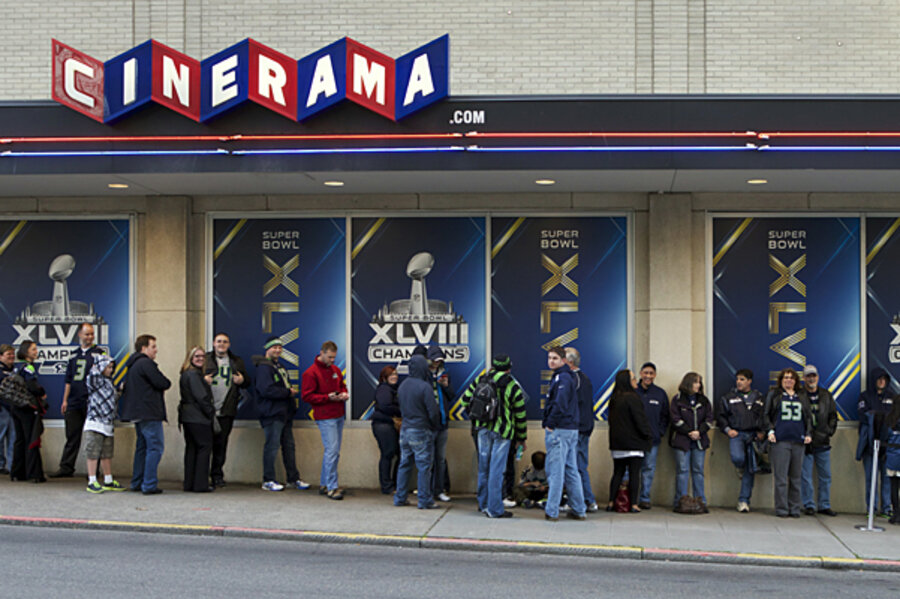Can movie theaters beat Netflix?
Loading...
| Somerville, Mass.
Just a few miles north of Boston, Peter Mattchen has to yell out to be heard during a noisy Saturday night at the Somerville Theatre.
" 'Monuments Men' at 7:20 is sold out," he shouts to the crowd lined up at the box office. The moviegoers let out a collective "Awww" – then break up into discussions about what to see instead.
"There's something special about sitting in a theater and watching movies," says Mr. Mattchen, the theater's house manager. "It's the exact opposite of what you get from Netflix.... This" – he gestures toward the venue's 900-seat auditorium with gold-leaf woodwork and a balcony – "is a great excuse" to leave the house to get one's entertainment.
But keeping movie houses alive has been tough for the industry, as the number of tickets sold has dropped over the past decade. Now moviegoers have the choice to go out – or stay on their couches and watch movies at home over high-speed Internet connections, using high-definition television screens and big surround speakers.
So theaters are pushing back by making the venues themselves part of the attraction.
"The goal here is to make going to the movies a more social experience, similar to a live event or show," says Darryle Ulama, an industry research analyst at IBISWorld, a business intelligence publisher in New York.
By improving the experience and charging higher ticket prices, the movie industry has been able to course-correct somewhat: It generated more than $14.4 billion in revenue and $722.7 million in profits in 2013, an increase of about 6.6 percent since 2004, according to Mr. Ulama.
AMC Entertainment, for example, has increased sales by cutting the number of available seats in some theaters. With more than 17 percent of the US market, the theater chain has converted 11 of its theaters to offer dinner menus and wait service. Those theaters also feature leather recliners for audience seating, says company spokesman Ryan Noonan. The conversions reduce seating by about two-thirds, according to AMC's filings with the Securities and Exchange Commission (SEC), but attendance at those theaters has risen by an average of 84 percent.
"We've tried to up our game at a number of theaters around the country, going in, removing all the traditional movie seats, and putting in incredibly comfortable recliners," says Mr. Noonan, "and the results are paying off in a big way."
The owner of the Somerville Theatre, FEI Theatres, has also upgraded equipment, spending about $1 million on new projection equipment for both its Somerville venue and its other location – the Capitol Theatre in nearby Arlington, Mass. – according to Mattchen. The theaters can now show films digitally and in 3-D.
Cinemas had to do something. From 1987 to 2002, movie admissions in the United States and Canada rose from about 1.09 billion to 1.57 billion, according to the National Association of Theatre Owners, the industry's chief US trade organization. Over the past decade, however, movie theater attendance has trended downward to about 1.36 billion in 2012.
In terms of revenues, the theater industry is still well ahead of digital content providers.
AMC, for example, brought in $2.7 billion in revenue from 200 million guest visits in its most recent fiscal year with a profit of $82.8 million, according to SEC filings.
By comparison, Netflix claims more than 44.3 million members as of last year, with revenues of $1.2 billion and a profit of $48 million, including income from its DVD service.
But Netflix is growing fast, adding about 4 million new subscribers in just the fourth quarter of 2013, according to its most recent earnings report. And the service has a pricing advantage: It charges $7.99 per month for unlimited use of its on-demand video library of films and television shows. The average movie ticket in 2013 cost $8.35, according to the National Association of Theatre Owners.
So theaters continue to rely on what sets them apart. Back at the Somerville Theatre, customers who see a film there are greeted by its restored century-old lobby – wood-framed glass doors, tan-tiled floors, green walls with red and gold trim, and the smell of popcorn in the air.
Jeremy Ebersole, a customer waiting to see "The Wolf of Wall Street" later that night, says that going to a movie theater can be a shared experience with other moviegoers. The venue can be a plus, too.
"I go to movies sometimes not because of the movie, but because of the theater itself," he says.







